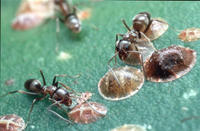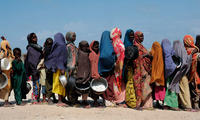-
New test for detecting newly emerging strains of drug-resistant superbug
Molecular assays for MRSA are used in active surveillance programs to identify colonized patients rapidly. Active surveillance is a proven strategy to reduce transmission in healthcare settings and it helps prevent infection in vulnerable patients. BD Diagnostics has received FDA clearance to market the BD MAX MRSA XT Assay for use on the BD MAX System. This is the second assay from BD Diagnostics capable of detecting newly emerging MRSA strains with the novel mecC gene.
-
-
Stimulating plant growth and increasing crop yields
Plants naturally slow their growth or even stop growing altogether in response to adverse conditions, such as water shortage or high salt content in soil, in order to save energy. They do this by making proteins that repress the growth of the plant. Growth repression can be problematic for farmers as crops that suffer from restricted growth produce smaller yields. Scientists have discovered a natural mechanism in plants that could stimulate their growth even under stress and potentially lead to better crop yields.
-
-
Reducing radioactivity in fracking waste
In hydraulic fracturing — or fracking — millions of tons of water are injected at high pressure down wells to crack open shale deposits buried deep underground and extract natural gas trapped within the rock. Some of the water flows back up through the well, along with natural brines and the natural gas. This “flowback fluid” typically contains high levels of salts, naturally occurring radioactive materials such as radium, and metals such as barium and strontium. Much of the naturally occurring radioactivity in fracking wastewater might be removed by blending it with another wastewater from acid mine drainage, researchers find.
-
-
Patients infected with drug-resistant bacteria at suburban Chicago hospital
Health authorities in Illinois have placed a suburban Chicago hospital under tight scrutiny after an extremely rare strain of a dangerous drug-resistant strand of flu was found to be connected to a series of operations performed at the hospital. The Centers for Disease Control and Prevention (CDC) has discovered forty-four cases of Illinois patients infected with a particular bacteria, and thirty-eight of those individuals had all recently undergone an endoscopic procedure at Advocate Lutheran General Hospital, located in Park Ridge west of Chicago, in the past year.
-
-
Europe facing more severe and persistent droughts
Drought is a major natural disaster that can have considerable impacts on society, the environment, and the economy. In Europe alone, the cost of drought over the past three decades has amounted to over 100 billion euros. Europe has been battered by storms in the last few years, but researchers warn that many river basins, especially in southern parts of Europe, are likely to become more prone to periods of reduced water supply due to climate change. An increasing demand for water, following a growing population and intensive use of water for irrigation and industry, will result in even stronger reductions in river flow levels.
-
-
Geoengineering measures to cool the planet would cause climate chaos
Geoengineering — the intentional manipulation of the climate to counter the effect of global warming — is being proposed as a last-ditch way to deal with the problems of climate change. New research suggests geoengineering could cause massive changes to rainfall patterns around the equator, drying the tropical rainforests in South America and Asia, and intensifying periods of drought in Africa.
-
-
Bioterrorism fears lead scientists to withhold information on new strain of botulism
The recent discovery of a new strain of botulism, the first in forty years, has alarmed California state health officials. The discovery was published in the Journal of Infectious Diseases in October 2013 — but the genetic sequence of the botulism toxin was removed from the report. The decision to withhold the sequencing information took into consideration the fact that there is currently no antitoxin capable of treating an outbreak of botulism, and that it takes about one to two years to develop an antitoxin. Should the classified information reach the wrong hands, a bioweapon, which can be spread as an aerosol, could be used to cause mass-casualty epidemic.
-
-
Improper use of biocides in food production poses public health risks
Biocides used in the food industry at sublethal doses may be endangering, rather than protecting, public health by increasing antibiotic resistance in bacteria and enhancing their ability to form harmful biofilms, according to a new study.
-
-
Killing bugs dead: “Attract-and-kill” technique tackles Argentine ants

After being inadvertently introduced in the United States from South America, Argentine ants have successfully invaded urban, agricultural, and natural settings nationwide. In urban California, the Argentine ant is among the primary pest ants. For example, this particular species of ants makes up 85 percent of ants sampled by commercial pest control companies in just the Greater San Diego Area. UC Riverside entomologists devise a novel “attract-and-kill” technique, which involves mixing a synthetic pheromone in insecticide sprays, to tackle the pest.
-
-
Preoccupation with bioterrorism hobbles preparations for natural spread of deadly viruses
Preoccupation with hypothetical bioterrorism attacks is leaving America more vulnerable to the threat of natural spread of deadly viruses. Since the 9/11 attacks, the federal government has poured billions of dollars to prevent and monitor threats of bioterrorism, yet the United States was ill-prepared for the swine flu outbreak of 2009. Experts say it is time to rebalance public health priorities so that preparations for the real threat of the outbreak of infectious diseases will not take a back seat to preparations for the more remote threat of bioterrorism.
-
-
Central African Republic, already mired in ethnic violence, faces another threat: famine

Since last year, when they had to flee the intensifying violence across the Central African Republic, farming communities had to abandon their fields along the main roads to replant deep in the bush. This disruption led them to produce much less than in previous years, with a major impact on their food reserves, which will last till February instead of July. The success of the next planting season crucially hinges on the return of farming families to the fields. Families who are unable to plant in March will have to wait one whole year before they can hope to harvest again. Failure to plant in March will have dire consequences for the food security of the Central African Republic’s population.
-
-
Extensive use of antibiotics in agriculture creating public health crisis

In the United States, 80 percent of the antibiotics are consumed in agriculture and aquaculture for the purpose of increasing food production. This flood of antibiotics released into the environment — sprayed on fruit trees and fed to the likes of livestock, poultry, and salmon, among other uses — has led bacteria to evolve.Mounting evidence shows resistant pathogens are emerging in the wake of this veritable flood of antibiotics — resulting in an increase in bacteria that is immune to available treatments. Scientists say that if the problem is left unchecked, this will create a health crisis on a global scale.
-
-
Breed-specific legislation does not protect the public from dangerous dogs

Research conducted by animal behavior experts challenges the basis of breed-specific legislation designed to protect the public from “dangerous” dogs.The researchers concluded that rather than making people safer, current legislation in the United Kingdom could be lulling them into a false sense of security.
-
-
Freshwater loss compounds climate change’s detrimental effects on agriculture
A warmer world is expected to have severe consequences for global agriculture and food supply, reducing yields of major crops even as population and demand increases.Agricultural models estimate that given the present trajectory of greenhouse gas emissions, climate change will directly reduce food production from maize, soybeans, wheat, and rice by as much as 43 percent by the end of the twenty-first century. Now, a new analysis combining climate, agricultural, and hydrological models finds that shortages of freshwater used for irrigation could double the detrimental effects of climate change on agriculturedue to the reversion of twenty to sixty million hectares of currently irrigated fields back to rain-fed crops.
-
-
Uranium found to be mobile in a natural wetland

Because they are known to mop up pollutants, artificial wetlands are considered to be an efficient strategy to contain waterborne uranium. Studying a natural wetland near a former uranium-mining site in the French region of Limousin, however, researchers have found that under certain circumstances, uranium can be partly remobilized into the surrounding water. The researchers show how it becomes mobile again by binding to tiny metallic and organic compounds with a little help from ambient bacteria.
-
More headlines
The long view
What We’ve Learned from Survivors of the Atomic Bombs
Q&A with Dr. Preetha Rajaraman, New Vice Chair for the Radiation Effects Research Foundation in Hiroshima and Nagasaki, Japan.
Combatting the Measles Threat Means Examining the Reasons for Declining Vaccination Rates
Measles was supposedly eradicated in Canada more than a quarter century ago. But today, measles is surging. The cause of this resurgence is declining vaccination rates.
Social Networks Are Not Effective at Mobilizing Vaccination Uptake
The persuasive power of social networks is immense, but not limitless. Vaccine preferences, based on the COVID experience in the United States, proved quite insensitive to persuasion, even through friendship networks.
Vaccine Integrity Project Says New FDA Rules on COVID-19 Vaccines Show Lack of Consensus, Clarity
Sidestepping both the FDA’s own Vaccines and Related Biological Products Advisory Committee and the CDC’s Advisory Committee on Immunization Practices (ACIP), two Trump-appointed FDA leaders penned an opinion piece in the New England Journal of Medicine to announce new, more restrictive, COVID-19 vaccine recommendations. Critics say that not seeking broad input into the new policy, which would help FDA to understand its implications, feasibility, and the potential for unintended consequences, amounts to policy by proclamation.
Are We Ready for a ‘DeepSeek for Bioweapons’?
Anthropic’s Claude 4 is a warning sign: AI that can help build bioweapons is coming, and could be widely available soon. Steven Adler writes that we need to be prepared for the consequences: “like a freely downloadable ‘DeepSeek for bioweapons,’ available across the internet, loadable to the computer of any amateur scientist who wishes to cause mass harm. With Anthropic’s Claude Opus 4 having finally triggered this level of safety risk, the clock is now ticking.”
“Tulsi Gabbard as US Intelligence Chief Would Undermine Efforts Against the Spread of Chemical and Biological Weapons”: Expert
The Senate, along party lines, last week confirmed Tulsi Gabbard as Director of National intelligence. One expert on biological and chemical weapons says that Gabbard’s “longstanding history of parroting Russian propaganda talking points, unfounded claims about Syria’s use of chemical weapons, and conspiracy theories all in efforts to undermine the quality of the community she now leads” make her confirmation a “national security malpractice.”
